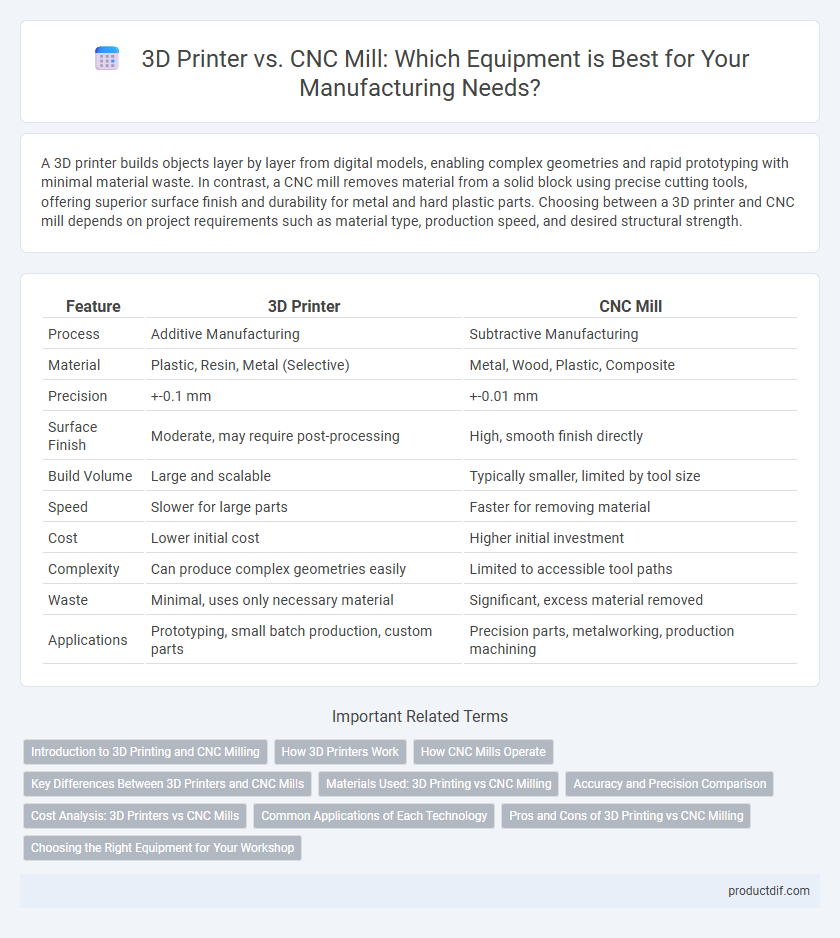A 3D printer builds objects layer by layer from digital models, enabling complex geometries and rapid prototyping with minimal material waste. In contrast, a CNC mill removes material from a solid block using precise cutting tools, offering superior surface finish and durability for metal and hard plastic parts. Choosing between a 3D printer and CNC mill depends on project requirements such as material type, production speed, and desired structural strength.
Table of Comparison
| Feature | 3D Printer | CNC Mill |
|---|---|---|
| Process | Additive Manufacturing | Subtractive Manufacturing |
| Material | Plastic, Resin, Metal (Selective) | Metal, Wood, Plastic, Composite |
| Precision | +-0.1 mm | +-0.01 mm |
| Surface Finish | Moderate, may require post-processing | High, smooth finish directly |
| Build Volume | Large and scalable | Typically smaller, limited by tool size |
| Speed | Slower for large parts | Faster for removing material |
| Cost | Lower initial cost | Higher initial investment |
| Complexity | Can produce complex geometries easily | Limited to accessible tool paths |
| Waste | Minimal, uses only necessary material | Significant, excess material removed |
| Applications | Prototyping, small batch production, custom parts | Precision parts, metalworking, production machining |
Introduction to 3D Printing and CNC Milling
3D printing builds objects layer by layer from digital models using materials like plastic or metal, enabling rapid prototyping and complex geometries. CNC milling removes material from a solid block through precise controlled rotary cutters, ideal for producing detailed parts from metals or plastics. Both technologies revolutionize manufacturing by offering distinct advantages in customization, accuracy, and material versatility.
How 3D Printers Work
3D printers create objects by depositing material layer by layer based on digital models, using processes such as fused deposition modeling (FDM) or stereolithography (SLA). Unlike CNC mills that subtract material through cutting and drilling, 3D printers build parts additively, enabling complex geometries with minimal waste. This additive manufacturing approach allows for rapid prototyping and customization in industries ranging from aerospace to medical devices.
How CNC Mills Operate
CNC mills operate by precisely removing material from a solid block using rotary cutting tools controlled by computer numerical control (CNC) software, enabling high accuracy and repeatability in complex three-dimensional shapes. Unlike 3D printers that build objects layer by layer through additive processes, CNC mills are subtractive machines that carve out a design through precise, multi-axis movements. The capability to use various cutting tools and materials such as metals, plastics, and wood makes CNC milling ideal for manufacturing parts requiring tight tolerances and superior surface finishes.
Key Differences Between 3D Printers and CNC Mills
3D printers build objects layer by layer using additive manufacturing, ideal for complex geometries and rapid prototyping with materials like plastics and resins. CNC mills operate using subtractive manufacturing, removing material from a solid block with high precision, typically used for metals and hard materials requiring detailed finishes. While 3D printing excels in customization and lightweight parts, CNC milling provides superior strength and surface quality for industrial applications.
Materials Used: 3D Printing vs CNC Milling
3D printers primarily use thermoplastics such as PLA, ABS, and PETG, along with resins and some metals like titanium alloys through selective laser melting, allowing for intricate designs and lightweight parts. CNC mills work with a broader range of materials including metals like aluminum, steel, brass, and various hardwoods, offering high precision and durability in machining. The choice between 3D printing and CNC milling depends on the material properties required, with 3D printing excelling in complex geometries and CNC milling preferred for robust, load-bearing components.
Accuracy and Precision Comparison
3D printers typically offer layer resolutions ranging from 20 to 100 microns, delivering high precision in additive manufacturing, while CNC mills achieve tolerances as tight as +-0.001 inches, excelling in subtractive processes. CNC milling provides superior accuracy due to rigid machine structures and precise tool positioning, ideal for metal parts requiring tight dimensional control. 3D printing's precision is optimal for complex geometries but may exhibit slight variations caused by material layering and thermal factors.
Cost Analysis: 3D Printers vs CNC Mills
3D printers generally offer lower initial purchase prices, ranging from $200 to $5,000, compared to CNC mills that typically start around $10,000 and can exceed $100,000 for industrial models. Operating costs for 3D printing remain minimal due to lower material waste and energy consumption, while CNC mills incur higher expenses through maintenance, tooling, and subcontracted programming. For prototyping and small-batch production, 3D printers provide a cost-effective solution, whereas CNC mills deliver superior precision and material versatility that justify their greater investment for large-scale manufacturing.
Common Applications of Each Technology
3D printers excel in rapid prototyping, custom parts fabrication, and complex geometries using additive manufacturing techniques ideal for plastics and some metals. CNC mills are preferred for precise machining of metal components, large-scale production, and parts requiring high strength and tight tolerances through subtractive manufacturing. Both technologies serve automotive, aerospace, and medical industries, with 3D printing offering flexibility in design iterations while CNC milling delivers durability and finish quality.
Pros and Cons of 3D Printing vs CNC Milling
3D printing excels at creating complex geometries and detailed prototypes rapidly with minimal material waste, making it ideal for intricate designs and low-volume production. CNC milling offers superior precision and surface finish on a wide range of materials like metals and plastics, suitable for high-strength, functional parts and mass production. However, 3D printing typically has slower build times and limited material strength, whereas CNC milling requires more setup time and generates more material waste.
Choosing the Right Equipment for Your Workshop
Choosing the right equipment for your workshop depends on project complexity and material type. 3D printers excel in creating intricate prototypes with plastic and resin, offering rapid iteration and low waste. CNC mills provide precision machining for metals and harder materials, suitable for producing durable parts with tight tolerances and repeatability.
3D printer vs CNC mill Infographic

 productdif.com
productdif.com